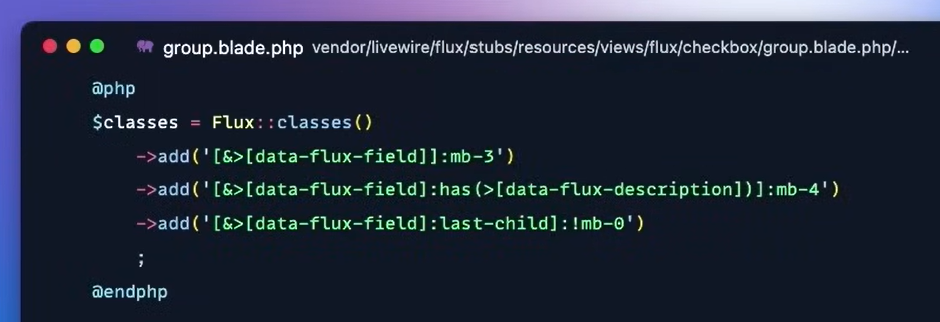Introducing Tailor for Laravel
Last updated
I'm excited to introduce Tailor, a Laravel package I've been working on to simplify class management in Blade components. Inspired by Caleb Porzio's Flux component library, Tailor brings a clean and elegant approach to handling dynamic classes and component variants.
The Inspiration
When Caleb first introduced Flux, he casually showcased a powerful API for managing classes within Blade components.

Seeing Flux::classes() in action—so clean, so elegant—I knew I needed something similar. Another standout feature was the ability to define component variants effortlessly:
<flux:button>Default</flux:button> <flux:button variant="primary">Primary</flux:button> <flux:button variant="filled">Filled</flux:button> <flux:button variant="danger">Danger</flux:button> <flux:button variant="ghost">Ghost</flux:button> <flux:button variant="subtle">Subtle</flux:button>
Absolutely beautiful! 🧽
Meet Tailor
Tailor builds on these concepts, providing a powerful yet intuitive API for managing classes, attributes, and variants in Blade components. Here’s a quick guide to how it works:
Getting Started with Tailor
// components/button.blade.php @props([ 'type' => 'button', 'size' => 'base', 'disabled' => false, 'tag' => 'button', 'variant' => 'ghost', ]) @php $c = Tailor::make('button'); // Configure attributes $c->attributes() ->merge($attributes->except('class')) ->if($tag === 'button', function ($set) use ($type) { $set('type', $type); }); // Define data attributes $c->data()->set([ 'variant' => $variant, 'size' => $size ]); // Define base classes $c->classes() ->base(['rounded-lg', 'border', 'ease-in-out', 'text-gray-800', 'font-medium']) ->focus(['focus:outline-none', 'focus:ring-2', 'focus:ring-offset-2']) ->match($size, [ 'xs' => 'px-2.5 py-1.5 text-xs', 'sm' => 'px-3 py-2 text-sm', 'base' => 'px-4 py-2 text-sm', 'lg' => 'px-4 py-2 text-base', 'xl' => 'px-6 py-3 text-base', 'default' => $size, ]); // Create the `primary` variant $primary = $c->variant('primary'); // Define styles for `primary` variant $primary->classes() ->light(['!text-inherit', 'bg-inherit', 'border-transparent']) ->hoverLight(['hover:text-gray-800', 'hover:bg-gray-300/60']) ->focusLight(['focus:border-gray-400', 'focus:ring-gray-400', 'focus:ring-offset-white']) ->dark(['dark:bg-gray-700/0']) ->hoverDark(['dark:hover:bg-gray-600/80']) ->focusDark(['dark:focus:border-gray-500', 'dark:focus:ring-gray-500', 'dark:focus:ring-offset-gray-900']); // Create the `secondary` variant $secondary = $c->variant('secondary'); // Apply the selected variant $c->setVariant($variant); // Merge any additional classes $c->classes()->merge($attributes->get('class', '')); @endphp // Render the button with all defined attributes <{{ $as }} {{ $c }}>{{ $slot }}</{{ $as }}>
Why Use Tailor?
Tailor helps streamline Blade components by making class management intuitive and maintainable. Whether you're building buttons, cards, or form elements, it provides a structured way to handle attributes, data, and styles dynamically.
I’d love for you to check it out and share your feedback. You can find Tailor on GitHub: Tailor. Let me know what you think!